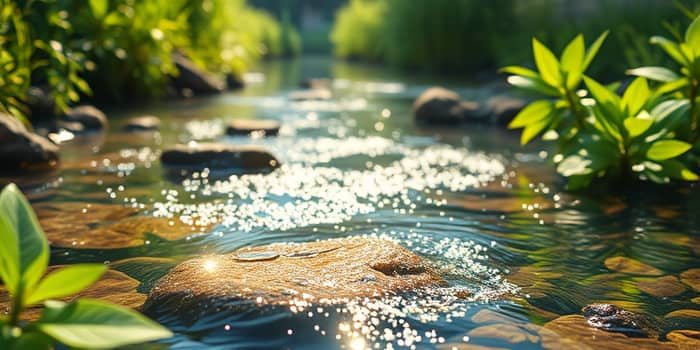Every festival, craft project, and makeup look has one secret ingredient: glitter. Yet while we revel in the shimmering magic, millions of microscopic particles are slipping down our drains and into the natural world. Traditional glitter is a silent invader, and its legacy is one of persistent plastic pollution. But a new hero is emerging from the very heart of plants, promising a future where shine and sustainability go hand in hand.
In this article, we explore the hidden dangers of conventional glitter, the pitfalls of so-called eco-friendly versions, and the groundbreaking science of cellulose nanocrystal (CNC) glitter. You’ll learn how to choose truly sustainable sparkles and why this innovation matters for our soil, waterways, and communities.
Why Traditional Glitter is a Hidden Threat
Most commercial glitter is made from a blend of polyethylene terephthalate (PET) microplastics and a thin aluminium coating. Once these fragments enter waterways, they become a persistent microplastic vector, infiltrating ecosystems and food chains.
Researchers estimate that nearly one million tonnes of microplastics, including glitter, wash into our oceans every year. In New South Wales, Australia, a study revealed that 24% of microplastics found in sewage sludge were glitter particles. These tiny shards resist degradation and accumulate in sediments, posing long-term risks to aquatic life.
- Soil fertility declines when springtail reproduction drops by 61% at high PET glitter concentrations.
- Marine animals ingest glitter, leading to gut blockages, toxic exposure, and disrupted food webs.
- Standard wastewater treatment cannot capture microplastics this small, so they flow freely into rivers and lakes.
The Illusion of ‘Biodegradable’ Glitter
Faced with public pressure, many companies have launched “biodegradable” glitter. However, these products often retain plastic coatings or aluminium layers, undermining their eco claims. In some cases, they can be as toxic as PET glitter for aquatic organisms.
The term biodegradable simply indicates eventual breakdown, not rapid or harmless decay. Some so-called biodegradable glitters require specific industrial composting conditions and may leave behind harmful residues if they end up in waterways. Consumers are left to navigate confusing labels.
Cellulose Nanocrystal Glitter: A Breakthrough
Scientists at the University of Cambridge and the University of Melbourne have developed a pure plant-based alternative derived from cellulose nanocrystals (CNC). Cellulose, a natural polymer found in all plants, offers a sturdy matrix for light-reflecting crystals without any plastic or aluminium coatings.
Manufactured through a process that extracts and purifies plant fibres, CNC glitter boasts a 100% compostable, plant-derived composition. It shines just as brilliantly as conventional glitter but disappears harmlessly in soil or compost, leaving no microplastic residue.
Ecological Impact: Soil and Water Testing
To verify safety, researchers conducted controlled exposure trials using springtails (Folsomia candida), key bioindicators for soil health. At contamination levels up to 1000 mg/kg glitter, cellulose glitter showed no adverse effects on reproduction or survival, whereas PET glitter reduced springtail offspring by 61% under similar conditions.
Further studies are underway to assess aquatic impacts, but preliminary data suggest that plant-based glitter poses negligible risk to fish, invertebrates, and water quality.
Choosing Truly Sustainable Glitter
With many products on the market, discerning authentic plant-based glitter can be challenging. Look for clear ingredient listings and independent certifications:
- 100% plant cellulose composition, no plastics.
- Free from aluminium, PET, and other microplastics.
- Certifications for compostability and biodegradability in natural settings.
Brands sourcing from responsibly managed forests or agricultural byproducts reduce carbon footprint and support responsible sourcing practices.
Commercial Options and Consumer Impact
Several ethical brands now offer plant-based glitter in a variety of colors and particle sizes. From festival-goers to DIY crafters, switching to cellulose glitter prevents tons of microplastics from polluting waterways each year.
The European Union banned loose plastic glitter and microbeads in 2023, aiming to cut microplastic pollution by 30% by 2030. Although Australia has not yet enacted similar regulations, consumer demand is driving change.
Looking Ahead: Challenges and Opportunities
While CNC glitter represents a revolutionary step, more research is needed on its behavior in aquatic environments and long-term soil systems. Continued innovation will refine production processes, reduce costs, and expand availability.
By embracing plant-based glitter today, we not only reclaim the joy of sparkle but also protect the rivers, oceans, and soils that sustain us. Every glittering eyelid and craft project becomes an act of environmental stewardship, ensuring that our celebrations leave only beauty, never pollution.
References
- https://pursuit.unimelb.edu.au/articles/plant-based-glitter-outshines-plastic-alternatives
- https://phys.org/news/2024-10-based-glitter-soil.html
- https://us.hemway.com/blogs/guides/is-there-environmentally-friendly-glitter
- https://pixiedust.eco/the-sparkle-of-sustainability-benefits-of-biodegradable-glitter-over-plastic-glitter/
- https://musaglitter.com/es/blogs/novedades/biodegradable-glitter-shine-without-the-environmental-impact-8
- https://www.mcsuk.org/what-you-can-do/ocean-friendly-living/reducing-your-plastic-footprint/all-that-glitters-is-not-gold/
- https://www.technologynetworks.com/applied-sciences/news/plant-based-glitter-does-not-harm-soil-organisms-392054
- https://www.treehugger.com/what-is-glitter-7095423










